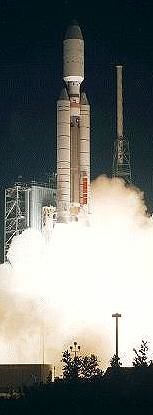
Home - Search - Browse - Alphabetic Index: 0- 1- 2- 3- 4- 5- 6- 7- 8- 9
A- B- C- D- E- F- G- H- I- J- K- L- M- N- O- P- Q- R- S- T- U- V- W- X- Y- Z
Titan 404B
 Titan 404 Credit: Lockheed Martin |
Status: Retired 2005. First Launch: 1999-05-22. Last Launch: 2005-10-19. Number: 3 . Payload: 21,680 kg (47,790 lb). Thrust: 15,000.00 kN (3,372,000 lbf). Gross mass: 910,000 kg (2,000,000 lb). Height: 54.00 m (177.00 ft). Diameter: 3.05 m (10.00 ft). Apogee: 1,000 km (600 mi).
LEO Payload: 21,680 kg (47,790 lb).
Family: orbital launch vehicle. Country: USA. Spacecraft: EIS, Misty, Improved Crystal. Launch Sites: Vandenberg, Vandenberg SLC4E. Stages: Centaur G, Titan 4-1, Titan 4-2, USRM. Agency: Martin.
1999 May 22 - . 09:36 GMT - . Launch Site: Vandenberg. Launch Complex: Vandenberg SLC4E. LV Family: Titan. Launch Vehicle: Titan 404B.
- USA 144 - .
Nation: USA.
Agency: NRO.
Class: Surveillance.
Type: Military surveillance satellite. Spacecraft: Misty.
USAF Sat Cat: 25744 . COSPAR: 1999-028A. Apogee: 3,100 km (1,900 mi). Perigee: 2,700 km (1,600 mi). Inclination: 63.50 deg.
This classified National Reconnaissance Office satellite represented the first successful Titan launch in four attempts. The payload had been reported to be a Lacrosse radar imaging reconnaissance satellite. However the short 50 foot Titan fairing was used instead of the 66 foot fairing used by Lacrosse. This only seems to be used previously for an Improved Crystal photo-reconnaissance satellite in November 1992. The payload therefore could be related to the ocean surveillance triplets, or be an Improved CRYSTAL derivative. Veteran amateur satellite-watchers believed it was the second launch of 'Misty', a stealthy optical reconnaisance satellite (the first launch being USA 53 in February 1990).
2001 October 5 - . 21:21 GMT - . Launch Site: Vandenberg. Launch Complex: Vandenberg SLC4E. LV Family: Titan. Launch Vehicle: Titan 404B.
- USA 161 - .
Payload: EIS-4. Mass: 16,650 kg (36,700 lb). Nation: USA.
Agency: NRO.
Manufacturer: Lockheed.
Class: Surveillance.
Type: Military surveillance satellite. Spacecraft: EIS.
USAF Sat Cat: 26934 . COSPAR: 2001-044A. Apogee: 1,050 km (650 mi). Perigee: 150 km (90 mi). Inclination: 97.90 deg.
Launch delayed from September 25, October1. National Reconnaissance Office payload that was placed into a sun-synchronous orbit. It was speculated that the payload was an Improved Crystal imaging satellite. That would imply an operational orbit of 150 x 1050 km x 97.9 deg orbit. The satellite belonged to the National Reconnaissance Office's fleet of Earth Imaging System (EIS) satellites. A BBC website reported a resolution of 10 cm in the images. (A commonly used name for the EIS satellites was Advanced Keyhole.) The first member of the EIS fleet was USA 144 (1999-028A), launched in May 1999.
2005 October 19 - . 18:05 GMT - . Launch Site: Vandenberg. Launch Complex: Vandenberg SLC4E. LV Family: Titan. Launch Vehicle: Titan 404B.
- USA 186 - .
Payload: EIS-5 / NROL-20. Mass: 20,000 kg (44,000 lb). Nation: USA.
Agency: NRO.
Class: Surveillance.
Type: Military surveillance satellite. Spacecraft: EIS.
USAF Sat Cat: 28888 . COSPAR: 2005-042A. Apogee: 1,050 km (650 mi). Perigee: 264 km (164 mi). Inclination: 97.90 deg.
Delayed from 2003; February 2004; and June 30, July 10, September 9, 2005. Last launch of the Titan series put a classified National Reconnaisance Office satellite into polar orbit. Its orbital parameters, as determined by amateur observors, suggested it was an Improved Crystal electronic imaging reconnaissace satellite, replacing USA 129, which was launched in 1996.
Back to top of page
Home - Search - Browse - Alphabetic Index: 0- 1- 2- 3- 4- 5- 6- 7- 8- 9
A- B- C- D- E- F- G- H- I- J- K- L- M- N- O- P- Q- R- S- T- U- V- W- X- Y- Z
© 1997-2019 Mark Wade - Contact
© / Conditions for Use